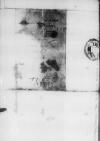Letter #978
Bona Sforza to Ioannes DANTISCUSVilnius, 1533-07-16
| received 1533-08-11 Manuscript sources:
Prints:
| ||||||||
Text & apparatus & commentary Plain text Text & commentary Text & apparatus
Reverendo in Christ paper damaged⌈[Reverendo in Christ]Reverendo in Christ paper damaged⌉o Patri, domino Ioanni paper damaged⌈[
Reverende in Christo Pater, sincere nobis dilecte.
Molesto tulissemus animo incendium, quod Paternitas Tua in bonis episcopatus sui pertulit, si id non a Deo permissum esset. Sed cum praeter Dei voluntatem nec capillus quidem capitis cadit, aequo ferenda sunt animo omnia, et
Ad mandatum serenissimae reginalis <m>aiestatis proprium


 BCz, 1601, p. 640
BCz, 1601, p. 640